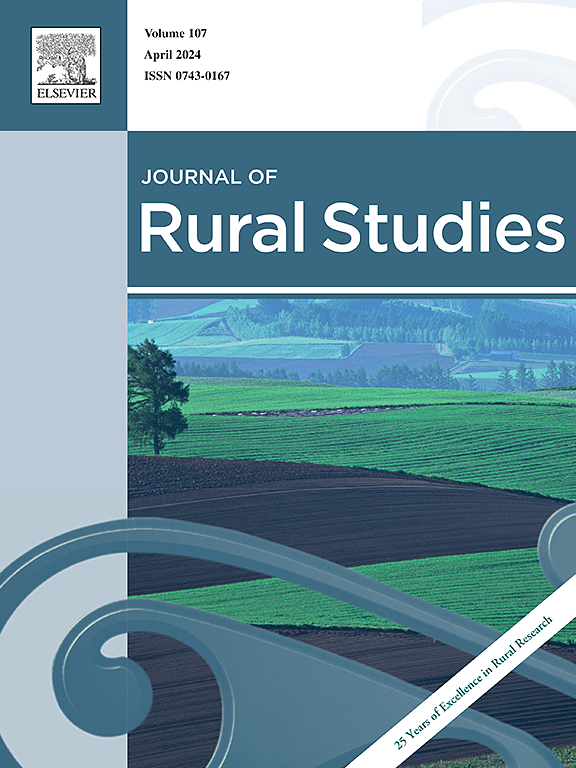Misaligned perceptions: Reverse effect of agricultural product brand image on consumer purchase intentions
IF 5.7
1区 社会学
Q1 GEOGRAPHY
引用次数: 0
Abstract
With the deepening of China's rural revitalization strategy and the increasing demand for green agricultural products at home and abroad, agricultural product branding remains one of the most important ways to promote rural economic development and agricultural transformation. The brand image of agricultural products has gradually become one of the reference standards for consumers to choose high-quality agricultural products, with a good brand image of agricultural products playing an important role in influencing consumer choice. This paper constructed a two-way interaction model for agricultural product branding based on the CBBE model and ERG theory. A multidimensional measurement framework was built for brand image, including functional, value, emotional, cultural, and visual dimensions. Structural equation modelling (SEM) was used to verify its impact on consumers' brand loyalty and purchase intention. A quantitative study was conducted on a random sample of 516 Chinese consumers using the whole cluster random sampling method. Results showed that functional, emotional, cultural, value, and visual dimensions of agricultural brand image had a positive effect on the brand image of agricultural products. The direct impact of agricultural brand image on consumer purchase intention was not significant. and had an inverse effect. Agricultural brand image had a positive and significant impact on brand loyalty. In addition, brand loyalty played an important role in mediating the relationship between brand image and consumer purchase intention. Finally, based on the results of this study, a case study of agricultural product brand image building - "Shangnong Youguo", was performed. This study emphasizes that brand image building for agricultural products requires a combination of five dimensions to achieve long-term brand loyalty. These findings provide insights for companies to develop a scientific and effective brand strategy and build a superior brand image. They also provide theoretical support for agricultural product branding and important implications for industry practice.

认知偏差:农产品品牌形象对消费者购买意愿的反向影响
随着中国乡村振兴战略的深入和国内外对绿色农产品需求的不断增加,农产品品牌化仍然是促进农村经济发展和农业转型的重要途径之一。农产品的品牌形象逐渐成为消费者选择优质农产品的参考标准之一,良好的农产品品牌形象对消费者的选择起着重要的影响作用。基于CBBE模型和ERG理论,构建了农产品品牌化的双向互动模型。构建了品牌形象的多维度测量框架,包括功能、价值、情感、文化和视觉维度。采用结构方程模型(SEM)验证其对消费者品牌忠诚度和购买意愿的影响。采用整群随机抽样的方法,随机抽取516名中国消费者进行定量研究。结果表明,农产品品牌形象的功能、情感、文化、价值和视觉维度对农产品品牌形象有正向影响。农业品牌形象对消费者购买意愿的直接影响不显著。并且产生了相反的效果。农业品牌形象对品牌忠诚度有显著的正向影响。此外,品牌忠诚度在品牌形象与消费者购买意愿的关系中起着重要的中介作用。最后,在研究结果的基础上,以农产品品牌形象塑造——“上农油果”为例进行了实证研究。本研究强调,农产品品牌形象的塑造需要五个维度的结合才能实现长期的品牌忠诚度。研究结果为企业制定科学有效的品牌战略,塑造卓越的品牌形象提供了参考。为农产品品牌化提供理论支持,并对产业实践具有重要意义。
本文章由计算机程序翻译,如有差异,请以英文原文为准。
求助全文
约1分钟内获得全文
求助全文
来源期刊

Journal of Rural Studies
Multiple-
CiteScore
9.80
自引率
9.80%
发文量
286
期刊介绍:
The Journal of Rural Studies publishes research articles relating to such rural issues as society, demography, housing, employment, transport, services, land-use, recreation, agriculture and conservation. The focus is on those areas encompassing extensive land-use, with small-scale and diffuse settlement patterns and communities linked into the surrounding landscape and milieux. Particular emphasis will be given to aspects of planning policy and management. The journal is international and interdisciplinary in scope and content.
 求助内容:
求助内容: 应助结果提醒方式:
应助结果提醒方式:


